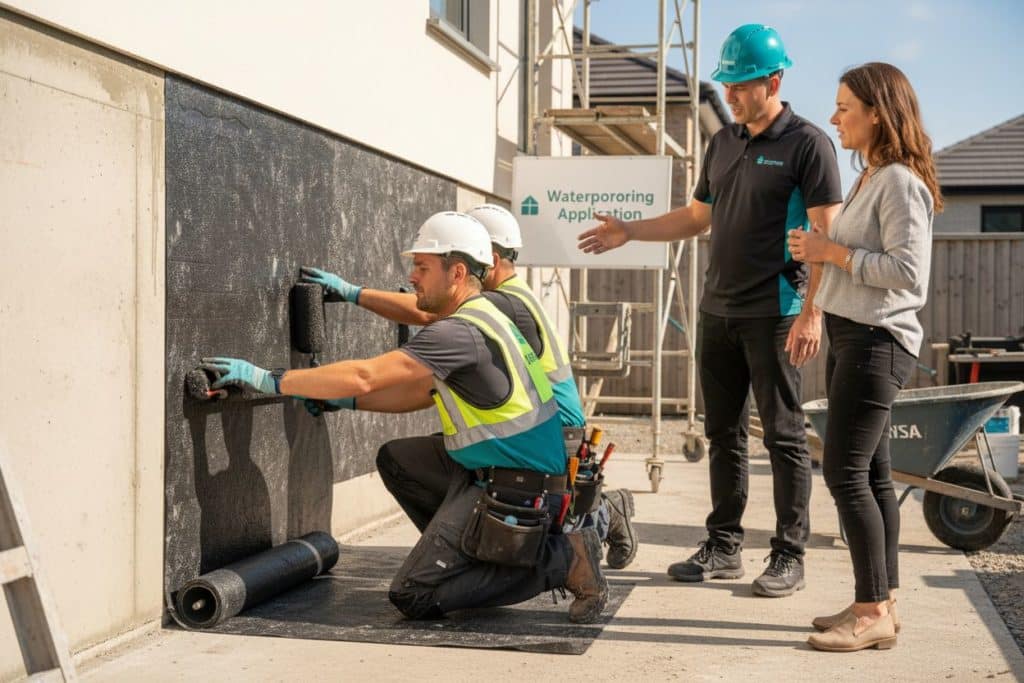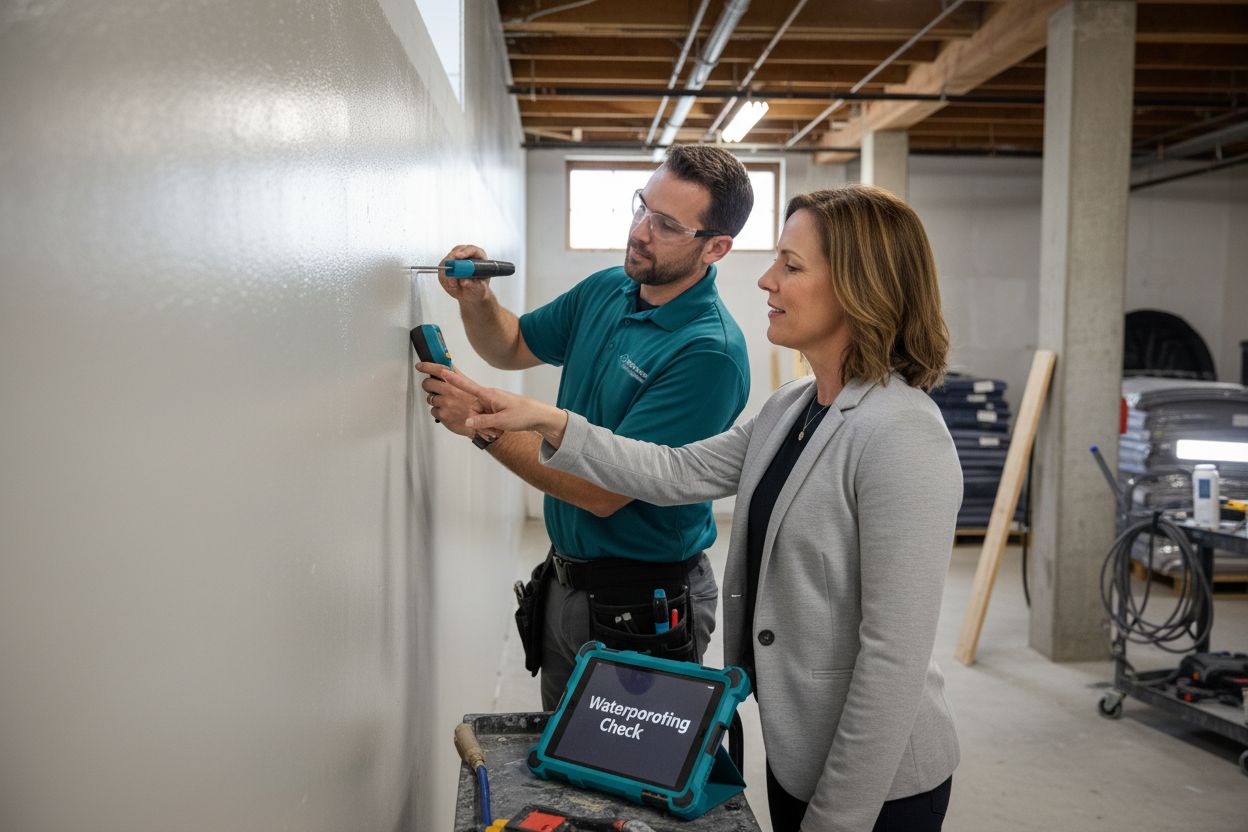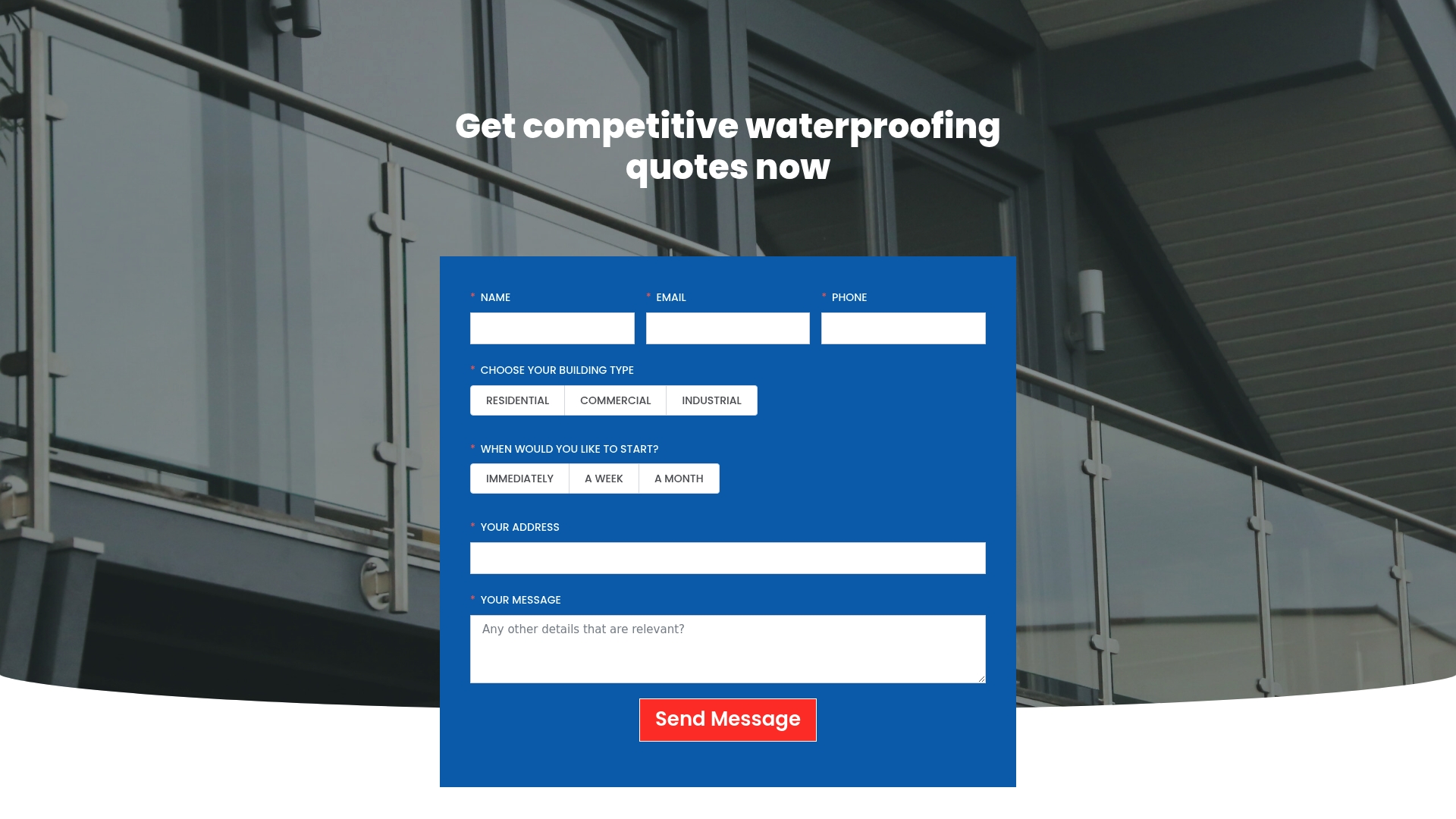Water damage is one of the silent destroyers of buildings, quietly weakening foundations and ruining interiors year after year. In fact, property experts estimate that over 80 percent of building defects are linked to improper waterproofing. It sounds shocking, especially when most people only worry about visible mould or a leaky roof. The real surprise is that waterproofing is never a cosmetic luxury, it is a make-or-break safeguard for the entire life of your property.
Table of Contents
- What Is Waterproofing And Why Is It Important?
- Key Types Of Waterproofing Materials And Their Properties
- How The Waterproofing Application Works In Different Settings
- Understanding Potential Issues And Maintenance Of Waterproofing
- Real-World Applications And Benefits Of Effective Waterproofing
Quick Summary
| Takeaway | Explanation |
|---|---|
| Waterproofing prevents severe structural damage | Implementing waterproofing is crucial to avoid water-related deterioration and maintain structural integrity across properties. |
| Mould growth poses health risks | Effective waterproofing minimizes moisture intrusion, significantly reducing the likelihood of mould and mildew that can affect indoor air quality and health. |
| Regular maintenance is essential for effectiveness | Conducting annual inspections and maintenance can help prevent waterproofing failures, ensuring lasting protection against moisture. |
| Choose materials based on specific needs | Selecting the right waterproofing material involves considering substrate type, environmental conditions, and expected water exposure for optimal efficiency. |
| Invest in waterproofing for long-term savings | Proactive waterproofing strategies can reduce future repair costs and increase overall property value by maintaining structural soundness. |
What is Waterproofing and Why is it Important?
Waterproofing represents a critical protective strategy for maintaining structural integrity and preventing water damage across residential, commercial, and industrial properties. At its core, waterproofing involves applying specialised techniques and materials to create barriers that prevent water penetration and moisture intrusion into building structures.
Understanding the Fundamental Concept
Waterproofing is not merely a surface treatment but a comprehensive approach to protecting buildings from potential water-related damages. Water damage prevention strategies reveal that uncontrolled moisture can lead to significant structural degradation, including foundation weakening, mould growth, and material deterioration.
The process involves creating sealed, water-resistant surfaces and systems that redirect or block water from entering critical building components. This protection extends across multiple areas:
- Foundations
- Exterior walls
- Roof structures
- Basements
- Underground spaces
Critical Importance for Property Preservation
Waterproofing serves multiple essential functions beyond simple moisture control. Proper waterproofing techniques provide long-term protection against:
- Structural damage caused by water infiltration
- Potential health risks from mould and mildew
- Reduction in property value due to water-related deterioration
- Expensive repair and restoration costs
By implementing professional waterproofing, property owners can significantly extend the lifespan of their buildings, maintain structural integrity, and prevent costly future repairs. Comprehensive waterproofing solutions demonstrate that proactive moisture management is far more economical than reactive damage control.
While water damage might seem like a minor concern, its potential consequences can be catastrophic. From compromising building foundations to creating unhealthy living environments, uncontrolled moisture represents a significant risk that cannot be overlooked. Waterproofing is not an optional luxury but a fundamental requirement for responsible property maintenance.
Property owners can read more about our waterproofing strategies to understand how comprehensive protection can safeguard their valuable investments.
Key Types of Waterproofing Materials and Their Properties
Waterproofing materials represent a sophisticated array of technological solutions designed to protect structures from moisture intrusion. These materials vary significantly in composition, application method, and performance characteristics, making selection crucial for effective water resistance.
Liquid Applied Membranes
Advanced waterproofing technologies demonstrate that liquid applied membranes offer exceptional flexibility and seamless coverage. These materials include bituminous coatings, polyurethane solutions, and acrylic polymers that can be directly painted or rolled onto surfaces.
Key characteristics of liquid applied membranes include:
- Excellent adhesion to various substrate types
- Ability to bridge small surface cracks
- Quick application and relatively low material costs
- Adaptable to complex architectural geometries
Sheet Membrane Technologies
Sheet membranes provide a robust, pre-fabricated barrier against water infiltration. Manufactured from materials like modified bitumen, PVC, and synthetic rubber compounds, these membranes come in rolls and are mechanically or chemically bonded to surfaces.
Their primary advantages encompass:
- High tensile strength
- Consistent thickness across entire surface
- Resistance to root penetration
- Long-term durability in challenging environmental conditions
Cementitious Waterproofing Systems
Cementitious waterproofing represents a traditional yet highly effective approach, particularly for concrete structures. These rigid, cement-based compounds create a dense, impermeable layer that blocks moisture penetration. Comprehensive waterproofing solutions highlight their particular effectiveness in underground and submerged environments.
Selecting the appropriate waterproofing material depends on multiple factors, including substrate type, environmental conditions, anticipated water pressure, and structural requirements. Property owners should consult professional waterproofing specialists to determine the most suitable material for their specific application.
The table below compares key types of waterproofing materials, highlighting their main properties to assist readers in selecting the most appropriate solution for their needs.
| Waterproofing Material | Application Method | Main Properties | Best Suited For |
|---|---|---|---|
| Liquid Applied Membranes | Painted or rolled | Excellent adhesion, crack-bridging, quick to apply, cost-efficient | Complex architectural forms, irregular surfaces |
| Sheet Membranes | Rolled and bonded | High tensile strength, uniform thickness, root resistant | Flat roofs, large commercial spaces |
| Cementitious Waterproofing | Mixed and applied | Rigid, dense, ideal for constant water pressure | Underground and submerged concrete structures |
For deeper insights into selecting the right waterproofing approach, read more about our membrane technologies to make an informed decision.
How the Waterproofing Application Works in Different Settings
Waterproofing application strategies differ substantially across various structural environments, requiring nuanced approaches tailored to specific architectural and environmental challenges. Understanding these variations ensures comprehensive moisture protection and structural integrity.
Residential Waterproofing Applications
Residential waterproofing techniques demand precision and adaptability. In homes, waterproofing focuses on critical areas prone to moisture penetration, including foundations, basements, bathrooms, and exterior walls.
Key residential waterproofing zones include:
- Foundation perimeter
- Basement walls and floors
- Bathroom and kitchen wet areas
- Roof surfaces and connections
- Exterior wall interfaces
Commercial and Industrial Waterproofing Approaches
Commercial and industrial settings require more robust waterproofing solutions that can withstand higher environmental stress. Advanced waterproofing strategies encompass comprehensive systems designed to protect large-scale structures against complex moisture challenges.
Primary considerations for commercial waterproofing involve:
- High-performance membrane technologies
- Chemical resistance requirements
- Thermal expansion accommodations
- Structural load bearing capabilities
- Compliance with industrial safety standards
Specialized Environmental Waterproofing
Certain environments demand unique waterproofing approaches beyond standard residential or commercial applications. Underground structures, marine facilities, and infrastructure projects require sophisticated moisture barrier technologies that can withstand extreme conditions.
Successful waterproofing implementation depends on comprehensive site assessment, understanding substrate characteristics, anticipated water exposure, and potential environmental stressors. Professional evaluation ensures selection of optimal materials and application techniques.
For comprehensive insights into selecting appropriate waterproofing strategies, explore our detailed roof waterproofing guide to understand nuanced application methods across different structural contexts.
Understanding Potential Issues and Maintenance of Waterproofing
Waterproofing systems, despite their sophisticated design, are not immune to potential failures and degradation. Understanding common issues and implementing proactive maintenance strategies are crucial for preserving the long-term effectiveness of moisture protection mechanisms.
Common Waterproofing Failure Mechanisms
Diagnostic approaches to waterproofing challenges reveal multiple pathways through which waterproofing systems can deteriorate. Structural movements, environmental stress, and material ageing contribute significantly to potential compromises in moisture barriers.
Predominant failure indicators include:
Below is an overview of common failure indicators and essential maintenance actions for waterproofing systems, helping readers quickly identify issues and maintain protection.
| Failure Indicator | Description | Recommended Maintenance Action |
|---|---|---|
| Visible water stains or dampness | Signs of moisture ingress or leaks | Inspect and reinforce affected areas |
| Hairline cracks in protective layers | Small splits in membranes or coatings | Repair cracks and reapply membrane |
| Discolouration or bubbling | Changes in coating appearance or blistering | Remove loose material and restore coverage |
| Musty odours | Presence of mould or persistent damp conditions | Improve ventilation and treat mould sources |
| Increase in interior humidity | Sustained elevated moisture in indoor air | Check waterproofing, assess drainage systems |
- Visible water stains or dampness
- Hairline cracks in protective membranes
- Discolouration or bubbling of surface coatings
- Persistent musty odours
- Unexplained increase in interior humidity
Critical Maintenance Considerations
Professional waterproofing maintenance requires systematic and comprehensive evaluation. Advanced waterproofing maintenance strategies emphasize regular inspections, targeted interventions, and proactive remediation techniques.
Key maintenance protocols encompass:
- Annual professional structural assessments
- Drainage system cleaning and verification
- Membrane integrity checks
- Reapplication of protective sealants
- Monitoring of potential stress points
Preventative Strategies and Professional Intervention
Effective waterproofing maintenance is not a reactive process but a strategic, ongoing commitment. Property owners must recognise that early detection and professional intervention can prevent exponentially more expensive structural repairs.
Critical elements of comprehensive waterproofing maintenance include understanding substrate conditions, recognising environmental challenges, and implementing targeted protection strategies. Professional waterproofing specialists can provide nuanced assessments that go beyond superficial inspections.
For deeper insights into identifying and addressing potential waterproofing vulnerabilities, explore our comprehensive guide on waterproofing failure detection to safeguard your property’s structural integrity.
Real-World Applications and Benefits of Effective Waterproofing
Waterproofing transcends mere technical necessity, representing a critical investment in structural longevity, property value preservation, and comprehensive asset protection. Its applications span diverse environments, each presenting unique challenges and opportunities for moisture management.
Residential Property Protection
Innovative waterproofing solutions dramatically enhance residential property resilience. Beyond preventing moisture intrusion, effective waterproofing delivers multifaceted benefits that directly impact homeowners quality of life and property investment.
Key residential waterproofing benefits include:
- Prevention of structural deterioration
- Mitigation of mould and mildew growth
- Enhanced indoor air quality
- Increased property market value
- Reduced long-term maintenance expenses
Commercial and Industrial Infrastructure Advantages
Commercial and industrial sectors experience profound economic advantages through strategic waterproofing implementations. Advanced waterproofing methodologies protect critical infrastructure, manufacturing facilities, and operational environments from potentially catastrophic moisture-related disruptions.
Significant commercial waterproofing advantages encompass:
- Minimised operational interruptions
- Protection of expensive equipment
- Compliance with safety and environmental regulations
- Extended infrastructure lifespan
- Reduced insurance and maintenance costs
Environmental and Economic Implications
Effective waterproofing represents a sophisticated risk management strategy that delivers substantial environmental and economic dividends. By preventing moisture intrusion, waterproofing directly contributes to sustainable building practices, energy efficiency, and resource conservation.
The economic rationale for comprehensive waterproofing extends beyond immediate structural protection. Proactive moisture management reduces long-term repair costs, prevents value depreciation, and supports sustainable infrastructure development.
For comprehensive insights into maximising your property’s protection, explore our professional waterproofing approach and understand how strategic moisture management can transform your asset’s longevity and performance.
Ready to Experience Professional Waterproofing That Lasts?
Understanding the waterproofing application process is not enough if you want real peace of mind. Many property owners struggle with persistent leaks, hidden dampness, and the stress of not knowing if their waterproofing will stand the test of time. The article you have just read highlights the importance of detailed application methods, precision at each stage, and the risk of future damage if even small steps are missed.
By trusting your project to the experts at Pro Waterproofing, you turn technical knowledge into long-term protection. Our team follows every best practice outlined in the process so you can avoid costly repairs, prevent mould, and defend your property investment.
If you recognise the value of a flawless application, do not wait until damage appears. Visit our specialist advice and service hub to explore tailored solutions or connect with our experts now at https://prowaterproofing.co.za. Secure a quote today and start protecting your property with confidence.
Frequently Asked Questions
What is the waterproofing application process?
Waterproofing application involves using specialised techniques and materials to create barriers that prevent water penetration and moisture intrusion in buildings. This can include liquid applied membranes, sheet membranes, and cementitious waterproofing systems, tailored to the specific needs of the structure.
How do I know which waterproofing material is suitable for my property?
Selecting the appropriate waterproofing material depends on factors such as the type of substrate, environmental conditions, anticipated water pressure, and specific structural requirements. Consulting with a professional waterproofing specialist can provide insights into the best options for your application.
What areas of a building typically require waterproofing?
Key areas that typically require waterproofing include foundations, basements, roofs, exterior walls, and wet areas within bathrooms and kitchens. Addressing these zones is essential for preventing moisture-related damage.
How can I maintain my waterproofing system to ensure its effectiveness?
Regular maintenance of your waterproofing system includes annual professional assessments, checking membrane integrity, cleaning drainage systems, and reapplying protective sealants as needed. Early detection of any issues can prevent more severe damage in the long run.



